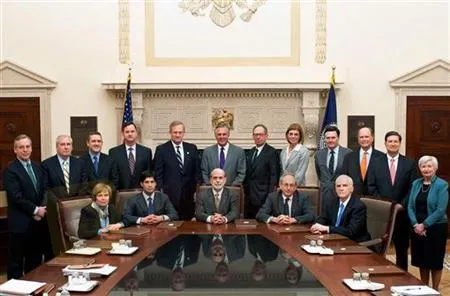简体中文
繁體中文
English
Pусский
日本語
ภาษาไทย
Tiếng Việt
Bahasa Indonesia
Español
हिन्दी
Filippiiniläinen
Français
Deutsch
Português
Türkçe
한국어
العربية
The FOMC Meeting is being traded
Abstract:The Federal Open Market Committee (FOMC) meets eight times a year to talk about and establish monetary policy in the United States. Each meeting is a significant event in the economic calendars of most traders. Speculation in the run-up to the meeting, as well as the aftermath, can cause flashes of volatility as markets respond to the Federal Reserve's choices.

The Federal Open Market Committee (FOMC) meets eight times a year to talk about and establish monetary policy in the United States. Each meeting is a significant event in the economic calendars of most traders. Speculation in the run-up to the meeting, as well as the aftermath, can cause flashes of volatility as markets respond to the Federal Reserve's choices.
Because of the relative secrecy of the meetings, anticipation usually builds as the date approaches. Only the seven governors of the board of governors and the presidents of the five Federal Reserve Banks are allowed to attend. The broad conclusion and significant decisions are disclosed at a press conference shortly afterward, but the complete minutes are not released for another three weeks - another day when market volatility is likely to escalate.
What does the FOMC make a decision on?
When it comes to possible trading possibilities, the markets often rise or fall in response to projected interest rate fluctuations. After evaluating a slew of economic data, the FOMC decides what type of intervention (if any) the US economy requires. It implements measures to raise or reduce interest rates depending on whether it wants to halt or accelerate inflation in order to maintain price stability. The Federal Reserve aims for a 2% annual inflation rate.
The conclusion of the FOMC meeting provides traders with an insight into the official assessment of the health of the US economy. Job growth, the unemployment rate, consumer spending growth, corporate fixed investment growth, and, of course, inflation are all factors considered by the committee.
Outside of the United States, the FOMC meeting is still a significant economic event. Because the United States possesses the world's largest economy, the FOMC's decisions have an impact that extends beyond its boundaries. When debating policy, it's also crucial to remember that the committee examines global economic trends and developments; the committee's hawkish or dovish leanings might provide significant insight into where other central banks may fall.
The FOMC has a direct impact on which financial instruments.
The FOMC has an influence on the following four key asset classes:
Currency pairings in US dollars. Higher interest rates, in general, increase the value of a currency. This is due to the fact that a higher rate tends to attract foreign investment, which in turn boosts demand.
Indices. Interest rate hikes placed downward pressure on consumer and company expenditure, causing stock values to fall. As a result, FOMC speculation frequently affects US indexes.
Bonds. Bond prices rise when interest rates fall and vice versa.
The dollar and gold have a roughly inverse relationship, which means that a weaker dollar can enhance gold's value. Furthermore, gold's reputation as a dependable safe-haven asset may entice investors if the FOMC decision predicts turbulent times ahead for the world or US economies.
Trading concerns at the FOMC
Day traders, in particular, may benefit from trading the FOMC as a risk event. Speculation about the Fed's intentions is typically so intense weeks before the meeting that any predicted interest rate change is essentially priced into the market by the time the meeting is announced.
This implies that if something unexpected occurs, the market may react dramatically. To profit from this turbulence, it's critical to have a thorough awareness of market sentiment and the ability to react swiftly if the Fed surprises and destabilizes markets.
Traders with a longer time horizon should be cognizant of the FOMC's market-moving potential. Any changes in interest rates often take over a year to be fully felt across the economy. As a result, while investigating a possible instrument, this time lag should be included into any investing decisions.

Disclaimer:
The views in this article only represent the author's personal views, and do not constitute investment advice on this platform. This platform does not guarantee the accuracy, completeness and timeliness of the information in the article, and will not be liable for any loss caused by the use of or reliance on the information in the article.
Read more

IG Group Acquires Freetrade for £160M to Expand UK Investment Market
IG Group acquires Freetrade for £160M, boosting its UK investment offerings. Freetrade to operate independently, with plans for growth and innovation.

Webull Launches SMSF Investment Platform with Zero Fees
Webull introduces commission-free SMSF trading, offering over 3,500 US and Australian ETFs, with no brokerage fees and enhanced portfolio tools.

April Fool's Day Scam Prevention Experience Collection
Share your “Forex Fraud Prevention Experience”, win WikiFX points and gold rewards!

How Will the Market React at a Crucial Turning Point?
Safe-haven assets like gold and U.S. Treasuries are surging, while equities face mounting pressure. As this pivotal moment approaches, how will the market react?
WikiFX Broker
Latest News
FCA Warns Against 10 Unlicensed or Clone Firms
CySEC Warns Against 14 Unlicensed Investment Websites
Top Currency Pairs to Watch for Profit This Week - March 31, 2025
Will natural disasters have an impact on the forex market?
Philippines Deports 29 Indonesians Linked to Online Scam Syndicate in Manila
Exposing the Top 5 Scam Brokers of March 2025: A Closer Look by WikiFX
Gold Prices Climb Again – Have Investors Seized the Opportunity?
Webull Launches SMSF Investment Platform with Zero Fees
Australian Regulator Warns of Money Laundering and Fraud Risks in Crypto ATMs
AI-Powered Strategies to Improve Profits in Forex Trading
Currency Calculator







